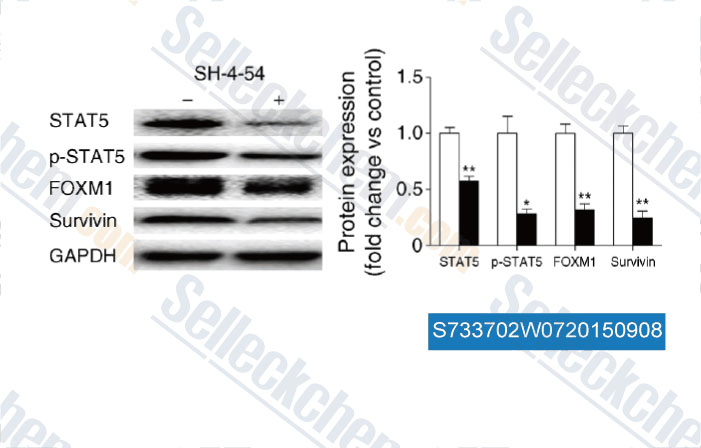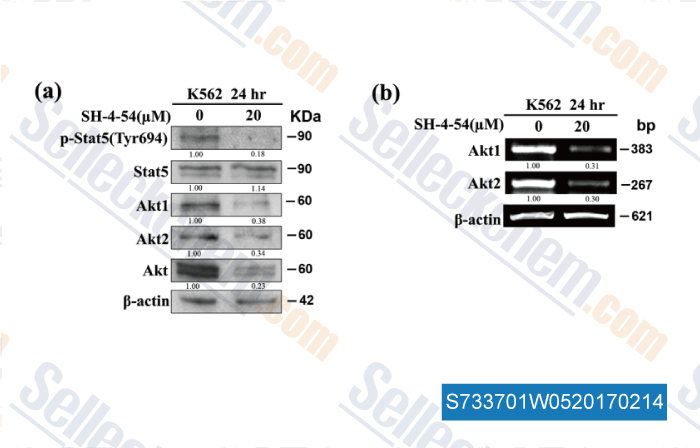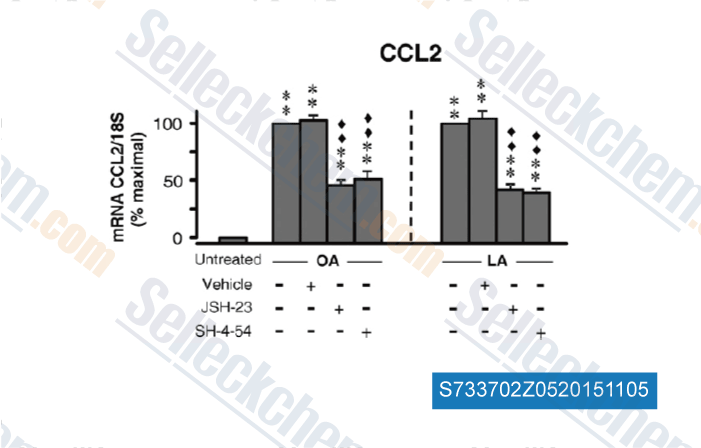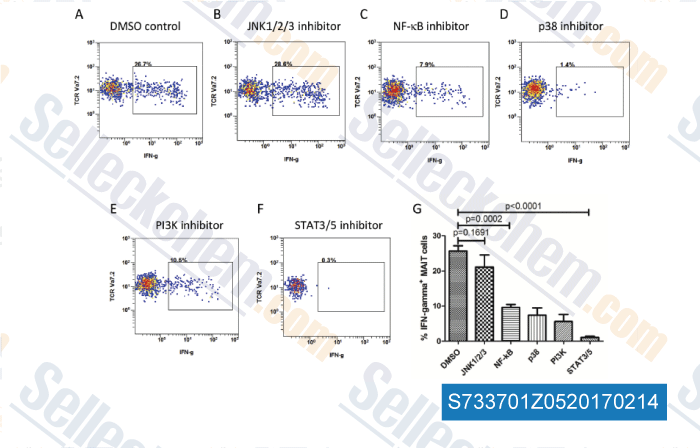|
Toll Free: (877) 796-6397 -- USA and Canada only -- |
Fax: +1-832-582-8590 Orders: +1-832-582-8158 |
Tech Support: +1-832-582-8158 Ext:3 Please provide your Order Number in the email. |
Technical Data
| Formula | C29H27F5N2O5S |
|||
| Molecular Weight | 610.59 | CAS No. | 1456632-40-8 | |
| Solubility (25°C)* | In vitro | DMSO | 100 mg/mL (163.77 mM) | |
| Ethanol | 79 mg/mL (129.38 mM) | |||
| Water | Insoluble | |||
|
* <1 mg/ml means slightly soluble or insoluble. * Please note that Selleck tests the solubility of all compounds in-house, and the actual solubility may differ slightly from published values. This is normal and is due to slight batch-to-batch variations. * Room temperature shipping (Stability testing shows this product can be shipped without any cooling measures.) |
||||
Preparing Stock Solutions
Biological Activity
| Description | SH-4-54 is a potent STAT inhibitor with KD of 300 nM and 464 nM for STAT3 and STAT5, respectively. | ||||
|---|---|---|---|---|---|
| Targets |
|
||||
| In vitro | SH-4-54 shows unprecedented cytotoxicity in human glioblastoma brain cancer stem cells (BTSCs), while has no toxicity in human fetal astrocytes. In addition, SH-4-54 effectively suppresses STAT3 phosphorylation and its downstream transcriptional targets. [1] | ||||
| In vivo | In mice orthotopically xenografted with BT73, SH-4-54 (10 mg/kg i.p.) exhibits BBB permeability, potently suppresses glioma tumor growth, and inhibits pSTAT3. [1] |
Protocol (from reference)
| Kinase Assay: |
|
|---|---|
| Cell Assay: |
|
| Animal Study: |
|
Customer Product Validation

-
Data from [Data independently produced by , , Diabetologia, 2015, 58: 2064–2073]

-
Data from [Data independently produced by , , Sci Rep, 2016, 6:33358.]

-
Data from [Data independently produced by , , Biochim Biophys Acta, 2015, 1852(12):2671-7]

-
Data from [Data independently produced by , , J Infect, 2016, 72(3):338-52.]
Selleck's SH-4-54 has been cited by 68 publications
| BTLA contributes to acute-on-chronic liver failure infection and mortality through CD4+ T-cell exhaustion [ Nat Commun, 2024, 15(1):1835] | PubMed: 38418488 |
| Blocking the MIR155HG/miR-155 axis reduces CTGF-induced inflammatory cytokine production and α-SMA expression via upregulating AZGP1 in hypertrophic scar fibroblasts [ Cell Signal, 2024, S0898-6568(24)00170-0] | PubMed: 38729323 |
| The Aconitate Decarboxylase 1/Itaconate Pathway Modulates Immune Dysregulation and Associates with Cardiovascular Disease Markers and Disease Activity in Systemic Lupus Erythematosus [ J Immunol, 2024, 213(4):419-434] | PubMed: 38949522 |
| JAK3/STAT5 signaling-triggered upregulation of PIK3CD contributes to gastric carcinoma development [ J Cell Commun Signal, 2024, 18(1):e12017] | PubMed: 38545256 |
| GM-CSF engages multiple signaling pathways to enhance pro-inflammatory cytokine responses in human monocytes during Legionella infection [ bioRxiv, 2024, 2024.12.05.627084] | PubMed: 39713445 |
| JAK-STAT Signaling in Inflammatory Breast Cancer Enables Chemotherapy-Resistant Cell States [ Cancer Res, 2023, 83(2):264-284] | PubMed: 36409824 |
| Homeostatic cytokines reciprocally modulate the emergence of prenatal effector PLZF+CD4+ T cells in humans [ JCI Insight, 2023, 8(22)e164672] | PubMed: 37856221 |
| CRISPR/Cas9-engineering of HMC-1.2 cells renders a human mast cell line with a single D816V-KIT mutation: An improved preclinical model for research on mastocytosis [ Front Immunol, 2023, 14:1078958] | PubMed: 37025992 |
| Single-cell transcriptome profiling of the immune space-time landscape reveals dendritic cell regulatory program in polymicrobial sepsis [ Theranostics, 2022, 12(10):4606-4628] | PubMed: 35832091 |
| Blockade of STAT3/IL-4 overcomes EGFR T790M-cis-L792F-induced resistance to osimertinib via suppressing M2 macrophages polarization [ EBioMedicine, 2022, 83:104200] | PubMed: 35932642 |
RETURN POLICY
Selleck Chemical’s Unconditional Return Policy ensures a smooth online shopping experience for our customers. If you are in any way unsatisfied with your purchase, you may return any item(s) within 7 days of receiving it. In the event of product quality issues, either protocol related or product related problems, you may return any item(s) within 365 days from the original purchase date. Please follow the instructions below when returning products.
SHIPPING AND STORAGE
Selleck products are transported at room temperature. If you receive the product at room temperature, please rest assured, the Selleck Quality Inspection Department has conducted experiments to verify that the normal temperature placement of one month will not affect the biological activity of powder products. After collecting, please store the product according to the requirements described in the datasheet. Most Selleck products are stable under the recommended conditions.
NOT FOR HUMAN, VETERINARY DIAGNOSTIC OR THERAPEUTIC USE.
